Ausstellungen
16.09. 19.11.2023
a house is a house is a home
Villa Romana
The open house and open studios of 16 and 17 September 2023 mark the reopening of Villa Romana as A House for Mending, Troubling, Repairing. The house opens its door to a wider public, one not just specifically engaged in art discourses and practices but committed to various forms of active citizenship, research, critical and ecological thinking.
It opens giving centre stage to the work of the four fellows who have been inhabiting the casa since February and March 2023: Diana Ejaita, Jessica Ekomane, Samuel Baah Kortey, Pınar Öğrenci. They have been participating and balancing the process of transition and continuity of the institution over the last months. Their presence, artistic research, and active engagement have been fundamental to the reframing of the agenda of Villa Romana, and have paved the way to some of the most substantial reflections articulated in this show. As curator Mistura Allison notes, they have embodied and multiplied the echoes vibrating in the Villa and beyond it, channelling past and future agencies of this artists’ house while at the same time digging into their own research and practice.
While the artists are opening their studios over the vernissage weekend, a multiform and growing exhibition – under the title a house is a house is a home - is also taking space in the rooms of the Villa, and in the public space, to support the reverberating of the echoes in a multidirectional way. And to plant seeds. As the house is lived, experienced, and animated by the artists and the team living in it - and by the many friends that are participating in its everyday -, in the same way the exhibition is conceived as a living organism: not something static and crystallised, for visitors to walk in and experience unaltered over the weeks, but a porous assemblage which is transforming, moving and growing according to the rhythms of the house and the needs and moods of its inhabitants. Because as A House for Mending, Troubling, Repairing the Villa is not a space for contemplation but one of action and relationality, of transformation and habitation. In a house, tables are often turning, chairs are relocated, items get moving, lost and sometimes reappear. Moods are also shifting, as sun, shade, and light change the form of the house and its experience across days and seasons.
A house is a house is a home, and its walls are not static but at times they can talk and dance, crumble and dust, shelter and oppress. Across cultures home is a never definite concept, but an experience. An experience that, beyond the West, is mostly collective and does not exhaust itself within the individual or the nuclear and biological family borders. It represents instead a chain of interconnected and ever inclusive intimacies, framed around interdependency and conviviality.
If at SAVVY Contemporary in Berlin we learned to live and embody a njangi house (Ndikung 2017), as an exercise of constant solidarity, here at Villa Romana we are also interested to experiment with the need of troubling the order of home. To put it with the words of Giulia Palladini, we see this as an opportunity and an outpost to rethink what a home might be, and to make clear that “it is the relation between the ‘political’ and the ‘domestic’ that needs to be carefully reconsidered, in politics as much as in art.” As she elaborates: “..to invent a different politics of use for the domestic, mending the fate of its predicament and imagining a possible future of redemption for all the activities which this word might evoke. (…) to call for a non-domesticated domestic, for a wild domestic, for an imaginative and unpredictable domestic. (..)to conjure a domestic beyond family and psychoanalysis, a domestic that already in fact exists in many realities, one built, defended and sustained by a multiplicity. A domestic not based on identity, but on a mode of being which makes human life possible and desirable.”
The current exhibition is not standing as staging of statements and a set of conducts. Along the lines of the children’s Takeover and free experimentation of few weeks ago or our co-writing of a policy of respect and co-habitation, we create a beehive of relations, a possibility of lived complexities and open interconnections, where conflictual pluralisation and processes are also played out, as in our “societies of negotiation”, to use Naika Foroutan’s words.
Home is not just a building, a place, or a physical unit, but rather a temporary outcome of permanent processes of negotiation, through which social norms and power structures are pondered, and unequal opportunities and resources in the distribution of ordering work may arise. This is what we address.
A House for Mending, Troubling, Repairing stands for a space embracing dissent and open to collective reflection; a place where normativity and canons are challenged; a house where artistic experimentation goes hand in hand with social repair.
Many are the doors and windows you will encounter and open while walking through the many rooms of this house. Consider each of them a threshold taking you to a personal space, but also as a hyperlink always allowing you to step back and retrace to the relational rhizome of interconnections that the house is setting. Through its history, and through its presences.

Public space is also embraced, to blur the boundaries between the personal and the political, between the private and the public engagement of our artistic reflection. Emeka Ogboh, who together with Chiara Figone (Archive Ensemble) served as juror for the Villa Romana Prize 2023 and has been supporting the work of our fellows throughout these months, is intervening with a newly commissioned edition of This Too Shall Pass – Tutto Passa, a multichannel sound installation at the Piazzale degli Uffizi, and a choir performance at the historical Società Canottieri Firenze. The work reflects on what singing together means in our society, especially in a (post)pandemic and a crisis-ridden world where music and art per se have long been sidelined by other urgencies, sonically interrupts the flow of one of the most crowded and symbolic squares in Italy, the Piazzale of the Uffizi.
Doing so it connects Villa Romana to the layered history of Florence while at the same time invoking and preluding the opening of the grand exhibition Camere con Vista. Aby Warburg, Firenze e il laboratorio delle Immagini at the Gallerie degli Uffizi on 18 September, curated by the Kunsthistorisches Institut (KHI), the Warburg Institute and the Uffizi itself.

As Juliane von Herz – curator and commissioner of the first iteration of the piece in Frankfurt – writes: “through sensory experiences such as hearing, seeing, tasting, smelling and feeling, Emeka Ogboh opens up cultural memory spaces. In his artworks, cooking and DJ performances, these memory spaces are sampled according to musical principles, their origins intertwined.”
Together with the Villa Romana Fellow Samuel Baah Kortey, Ogboh is inviting the public to a multi sensorial experience on the evening of 16 September at Villa Romana: Florence na so so enjoyment, a session at the barbecue in our garden with small chops and music. This special convivial moment will continue with a DJ set by Emeka Ogboh, another integral part of the piece This Too Shall Pass - Tutto Passa.

To expand on the further warburgian polysemic possibilities, in the communal spaces of Villa, Archive Ensemble presents an iteration of its Haptic Library, “reimagining libraries as communal displays for collective interaction and various cultural formats based on anti-colonial and feminist thinking and practice”. Using readings, textiles, and music as multi-sensorial mediums for archiving and disseminating narratives and knowledges, the Haptic Library redirects its focus beyond the printed book and the western fever of accumulation and the dominant sense of sight towards the sense of touch, and features plural perspectives and forms of story-telling across regions, generations, and epistemologies.
The installation and relational library might be found in the office space, or in other places according to the movements, the needs and the moods of the inhabitants or beings living the house, as all other pieces in this installation. As in a home and shared space, you are asked to find out what is where, and to attune to the rhythms and the uses of the house and the people who are living there.
As soon as you enter the gate of the Villa you encounter Diana Ejaita’s textile installation, six printed fabrics imbued with rich abstract symbolisms. They welcome the visitor in a multisensorial way, and they filter the view to the bourgeois architectural succession of rooms, multiplying layers of opacity and of epistemological dissent and imagination. You can arrive at the atrium, the main crossroad of the house – where many echoes and soundscapes as many visual perspectives are merging and being woven together -, or you might walk back to the side rooms, where Pınar Öğrenci’s films are shaping time and space. The first piece you encounter, entitled Snow (2023), paves as a detail to scenographies highlighted in Aşít (2022) highlighting themes of displacement, migration, survival, and resistance. As you navigate through the snow, Öğrenci’s three-channel film installation, Hotel Miks (2023), reverberates the convivial mundanity of life in the Villa; albeit at the artist’ father’s hometown of Miks (or Müküs in Kurdish, Moks in Armenian, Bahçesaray in Turkish) in the province of Wan. In the atrium a selection of photographs and documents from the historical archive of Villa Romana are presented, to set a tone and give a background to the articulations and ruminations that the exhibition tries to bring to the fore. Reproductions from the first moments of the grounding of this artists’ house – all documents from the first decades of the institutions are lost, as during World War II, the archive was sent to Berlin and the building where it was stored got bombed -, as well as original photographs and images of convivial and artistic life in the Villa. Together with Carlotta Castellani, who is currently in charge of leading research in the archive in the prospect of our 120 years anniversary, we highlighted moments and works that created ruptures and change of trajectory in the life of the Villa. Some that allow us to build on the current research directions of the institution, such as feminist troubling, diasporic belonging, commonality, ecological sustainability, and decanonisation.
The work of three artists in particular are brought to the fore: three women – not three mythological Parcae - whose research intertwines with some of the threads that we are weaving together in this exhibition and programme.
Anna Oppermann, Villa Romana Fellow in 1977, is presented with her monumental and subtle Ensembles, three-dimensional wall installations brought together as open collections and arrangements, sometimes consisting of several hundred picture screens, photographs, drawings, objects, sculptures, architectural elements, writing panels and writing tapes. They were elaborated by the artist as image and thought processes spread out in space, and as reflections about transitions between reality and fiction. An interesting visual echo and conceptual counterpoint to the working method of Aby Warburg and his Mnemosyne Atlas, which is in these days pondered in the exhibition Camera con Vista curated by Gerhard Wolf and the Kunsthistorisches Institut at the Gallerie degli Uffizi, with which we are intertwined.
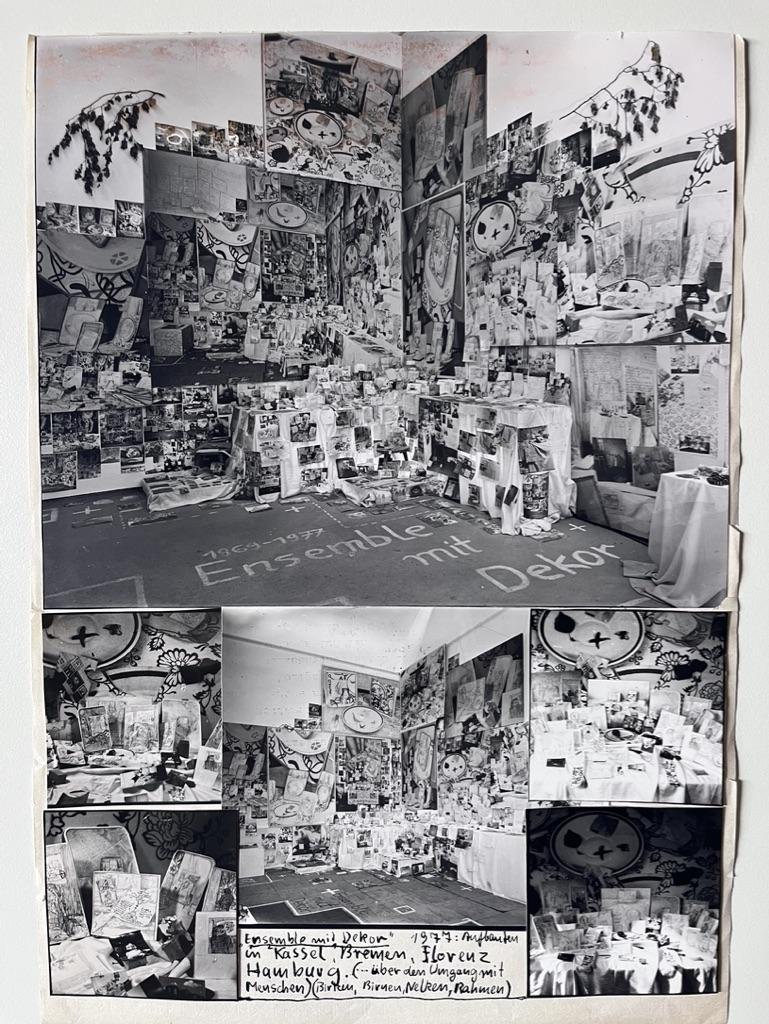
Ulrike Rosenbach, who was hosted here as a visiting fellow in 1977 together with other figures such as Martin Kippenberger, Marcel Odenbach and Klaus vom Bruch, brings to the fore a feminist performative practice that is still inspiring many discussions and reflections in the house. At the end of July 1977, the residents at that time organised an evening of performances in and around the garden entitled Künstler arbeiten für Künstler [Artists work for artists]: during that evening Rosenbach wrapped a 1370m long red thread ten times around the house, a measure to represent the distance from Villa Romana to her home (1370km), wrapping the remaining part around her legs while laying down on a labyrinth of candles and showing the symbol of the Italian women’s movement with her hands in the air. The next day she used the same thread that she cut to cover the head of the “dumme (dumb)” (as she calls her) Medici-Venus at the end of the driveway to Villa Romana.

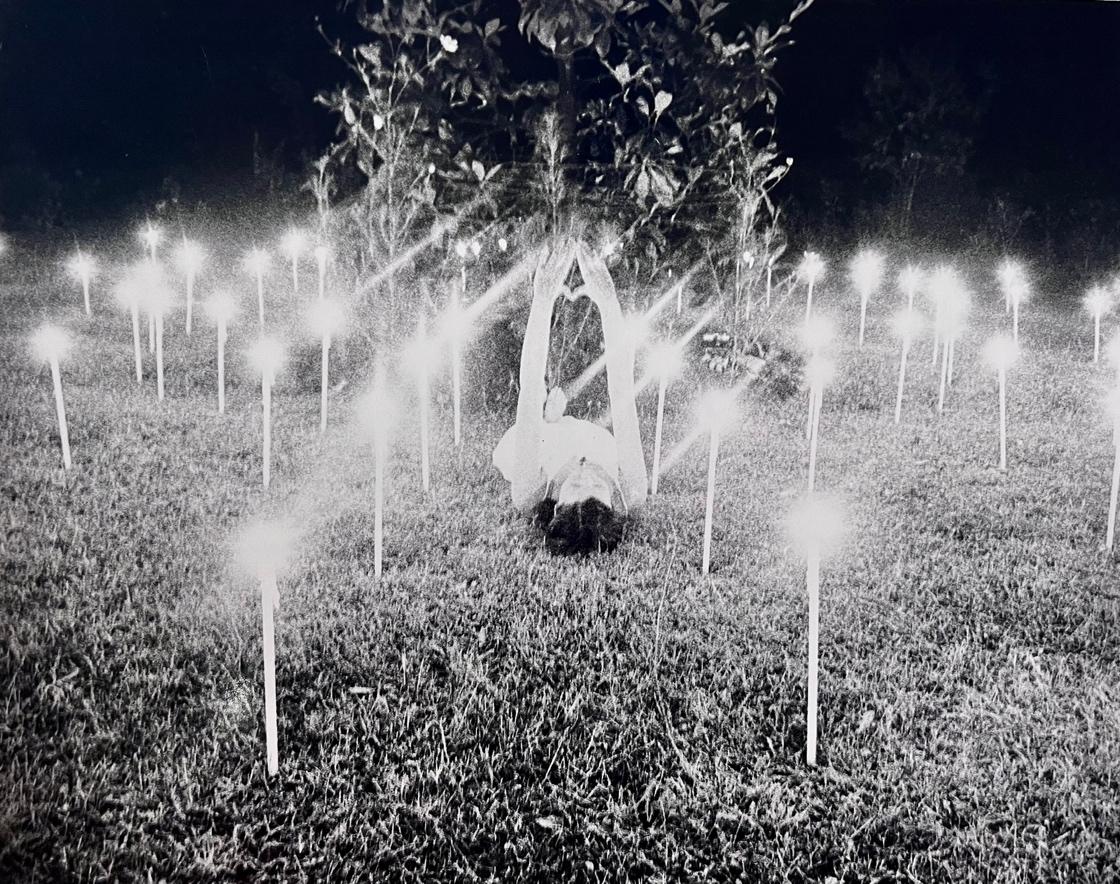
Dorothee von Windheim was awarded the prize in 1975. Her work is literally concerned with the practice of the Strappo, pondering the ephemerality of traces and the philosophical meaning of fractures, as much as the notions of framing and of index. Decontextualising plaster from old and more recent buildings, the artist was interested in shedding light to the (non)history of the everyday but also to reflect on the individuality that an anonymous part of public space is suddenly gaining by being transposed in an art context. Another interesting deliberation in the House for Mending, Troubling, Repairing.

The exhibition continues multidirectionally, subject to the visitor’s choice to follow this or that voice and path.
Following the stairs further up the house, we are captured by a multichannel sound piece by Jessica Ekomane, Untitled 1, to be experienced bodily and while moving up along the larger stone stairs of Villa Romana. A separate curatorial text by Mistura Allison is accompanying you to delve into the layered and pondered work of our fellows, and their particular contributions in this exhibition. But the theoretical and mathematical complexity of Jessica’s work requires your focused cognitive collaboration.
Arrived at the first balcony, you can confront the hypnotic and pulsing piece by Stephany Nwobodo - Genesis (2023)- a painting carved out in one of the architectural lunettas of the atrium, reviving ancient masks from the Igbo knowledge system. Namely, the Adamma Masquerade is juxtaposed with seven peacock feathers, transcending female beauty and functioning as an invocation of past and future good spirits in the house. A protection for the fellows, for the house, and for the people able to read these signs and codes.
On the highest balcony, turning back to the stairs and the stairwell, the short film Forensic for a Mamluk by Shannon Bool (Villa Romana Fellow 2013) is installed. The piece, from the collection of Villa Romana, presents an analytical bird’s-eye view of a masterpiece of decorative art, the giant Egyptian Mamluk carpet from the first half of the 16th century. The carpet was forgotten among stored items of the Palazzo Pitti until it was rediscovered in a sealed chamber at the palazzo by Alberto Boralevi, a Florentine carpet expert, in 1982. The object was forgotten due to the historical bias that positioned the decorative arts as inferior to painting and sculpture. For us it does not only give us the opportunity of unfolding a non-Western epistemological approach to the study of images and artefacts, but it also symbolises the intention of renegotiating domesticity, it embodies the literal gesture of mending and weaving, and it opens up a strong connection to our garden.
Walking on the first floor, through the octagon, to the artists’ studios and apartment of Diana (on the right) and of Pinar (on the left), you suddenly find yourself in a high-ceiled space, an empty geometry that goes as a carved-out tower up to the roof of the Villa. Looking down, you can encounter another film by Pınar Öğrenci, a piece from Un Peso, taking us to the city of Acapulco, Mexico.
Climbing the steepest and tightest steps of the house, a wall faces you with all the names of the Fellows awarded the Villa Romana Prize from 1905 until now. A long list of some gone and many still living artists who gained recognition throughout history.
The parcours takes you either to the terrace, where a sound installation by the in-house radio – Radio Papesse by Ilaria Gadenz and Carola Haupt – is echoed, or to the library of the Villa. On the occasion of the Open Studios 2023, they present Echoes from troubled bodies, an immersive installation showcasing selected voices from the Radio Papesse archive, namely by Ananda Costa, Alessandra Eramo, Adriene Lilly, Jasmina Metwaly (Villa Romana Fellow 2022), and Josèfa Ntjam. They all ponder the body as a site of discourse, making use of them as sounding boards and sound instruments.
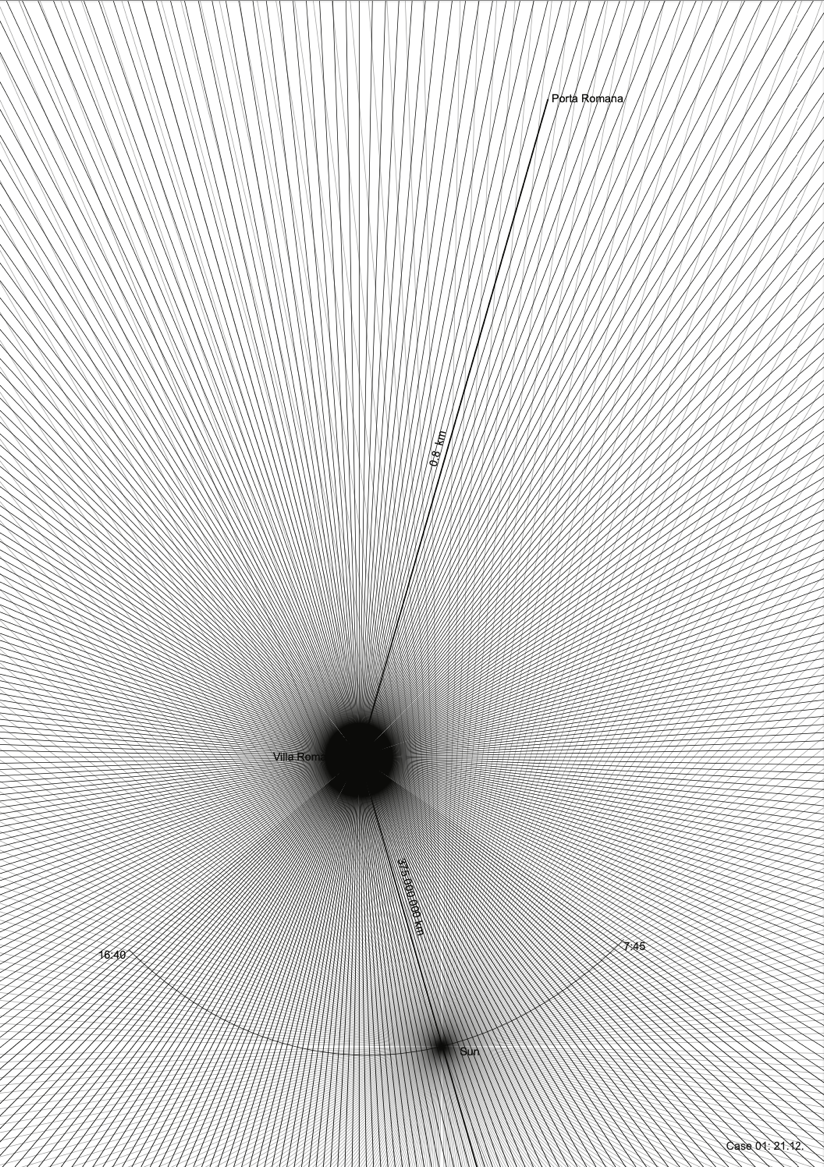
On the same roof, another kind of multisensorial experiment is unfolding over the course of the exhibition and throughout the year, as a journey towards the solstices: Ivana Franke’s piece Suncostaj. An instrument capturing sunrays has landed on the highest point of the Villa, rendering sunlight visible by bouncing it towards visitors and roaming in the city. It appears as a liminal glare instigating curiosity rather than a mark or a signpost - a ‘navigational star’ delineating invisible trajectories, possible paths of movement from different locations in the city. A visual echo from Villa Romana to be unexpectedly experienced by inhabitants and passers-by of the city of Florence. Not a lighthouse but a day star, to invoke presence and those who feel called to the House of Mending, Troubling, Repairing.
Descending the stairs and walking through the corridor where different guest artists' studios and rooms are encountered in succession, one gets to another pulsing heart of the Villa: the library and archive, where thousands of books are made available to the use of residents and researchers. Here filmmaker Aline Benecke presents the piece Can we not be so self-centered and keep our experiences to ourselves? Diasporic remembrances of Fasia Jansen, a piece that grapples with the memory of the German political singer-songwriter and peace activist Fasia Jansen. Fasia was born in 1929 in Hamburg as the illegimate daughter of white German maiden Eli Jansen and liberian consul Momolu Massaquoi. She witnessed the suffering of Jewish Women in the Camp of Neuengamme, where she was imprisoned to do forced labour. After this and many other traumatic experiences, Fasia dedicated her life to different political struggles, and became active in women*-, labour-, anti-atom- and peace movements, writing an impressive collection of protest songs. As Benecke writes: Our longing was to relate to Fasia from a Black queer Perspective, to understand her positionality and hence to negotiate ours. We did so by gathering and re-enacting her songs and spirit. Our choir – the Fasia Jansen Ensemble – is a spiritual invocation. The piece won the Villa Romana award of this year’s ADCF, the African Diasporic Cinema Festival founded and directed by Fide Dayo, another resident of the Villa Romana. For us here it functions as a reflection on the importance of the making and the cultivation of dissident archives, and the need of troubling heteronormative historical memory. At the same time, it materialises as a chorus of activists’ voices that resonate throughout the space of the house in polyphony and in echoes.
Back to the corridor of the same floor, you will find the rooms of the guest artists: artists and practitioners that are co-inhabiting the Villa with us for a shorter period. The rooms are four, and among them you will find one which was named after Hans Purrmann and that in the House For Mending, Troubling, Repairing is in the process of being renamed collectively. Living at the moment in the room is artist Erik Tollas, a ERIAC (European Roma Institute for Art and Culture) and Villa Romana residency guest, who is partaking in the Open Studios and the exhibition a house is a house is a home. Inspired by the garden of Villa Romana and its presences, Tollas produced three new pieces that you will find dispersed in the green: Indian summer with flowers, Olive yard at night, and Honeydew teardrops.
The room opposite the former Hans Purrman room is named Superstudio. The Superstudio furniture that are giving the name to the room are an artwork by Marine Hugonnier: pieces from her individual exhibition, which was on view at Villa Romana in Summer 2009, are now arranged in a guest room as a permanent installation: a bed, a wardrobe, shelves and three small tables. As you can read on our website for her exhibition, the French artist Marine Hugonnier had cloned prototypes from the “Misura” series by “Superstudio”, the radical group of architects in Florence in the 1970’s. She thought of the concept of cloning as a contemporary reproduction technique. In practice, Hugonnier subtly altered the dimensions, and the proportions respectively, of the individual objects. This idea of cloning has opened up the possibility of a critical reappraisal of the concerns of “Superstudio” with respect to those of the present day.
The last room on the right is the somewhat mythical and - from what all people sleeping there say - intensely inspiring Álvaro Urbano Room (formerly named after Arnold Boecklin), another permanent-installation-as-a-guest-room that resembles a dreamlike crypt: the bed rises from the ground as if levitating. Old stone and terracotta sculptures, display cases and archaeological finds excavated in the garden seem to emerge alongside the bed like communicating vessels in a hermetic dream. The Psyche of Capua resurfaced from the garden watches over the sleeper and assists his awakening. A window opens from the sloping ceiling, from which blades of grass can be glimpsed in a roof garden high above.
The room connects to another piece left by Álvaro during his residency as Villa Romana Fellow in 2014: in the garden, on the left side next to the gazebo taken over by the jasmine, the piece Observatory is carved out as a nocturnal bed, suggesting buried association to the Hypnerotomachia Poliphili, to Böcklin, Edgar Allan Poe, Ebdòmero, Bréton, Dali, Buñuel, Tatì, Jodorowski, horror cinema, etc. The piece has been restored for the occasion of the Open Studios 2023 and the exhibition, and the public is invited to activate the piece and relate to it anew. This piece will be in fact soon included in the Healing Garden that we are planting and taking care of during the autumn.
Returning down the stairs, in reverse along the path taken on the way up or walking down the smaller stairway, you will re-ecounter the main hall, the fork from where different routes departed. There you will walk towards the garden and will find the main Sala Giardino, our biggest and most renowned room, used for different public activities and communal moments. Here our fellow Samuel Baah Kortey is presenting a new set of works produced during his time here in Florence: a large scale painting reconnecting to the art of African wax prints and in particular to the tradition of commemorative fabric prints of prominent figures as a symbol of strength and identity in the face of oppression. The canvas, part of the artist’s series Do This in the Remembrance of Us is aptly titled Na Who Give Up, Messop, unfolds throughout the length and the width of the room, while its materiality gets amplified by the sound piece Our Village People (Do This In Remembrance of Us). Samuel also accompanied the visitors throughout the navigation of the house, installing smaller works in different corners of the Villa, mysterious presences emerging on the walls like webs or like living organisms: the pieces are part of the series Chris-sis; Inaccessible files 00BC-Forever III, which ponders and addresses the hyper-visibility of the Christian crucifix and Christian iconography within the urban landscape of his home country, Ghana, and alludes to the commercialisation of that religious symbol.
Download(pdf): Booklet: a house is a house is a home
.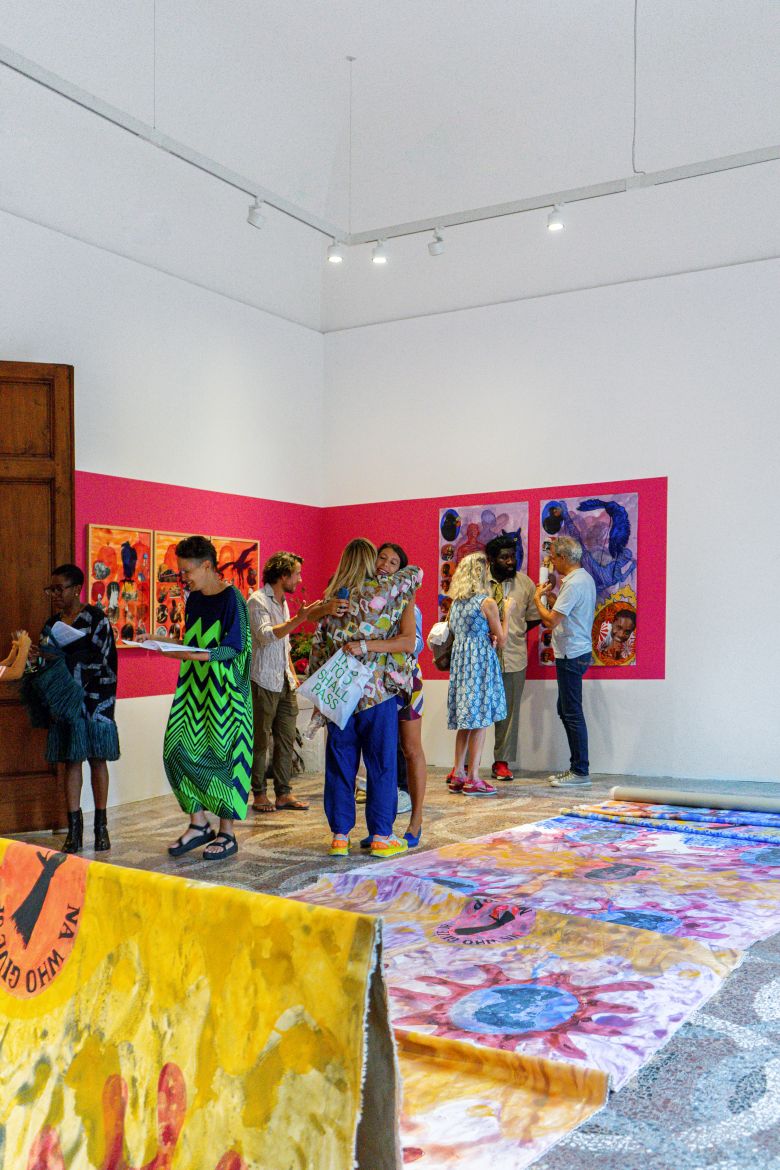

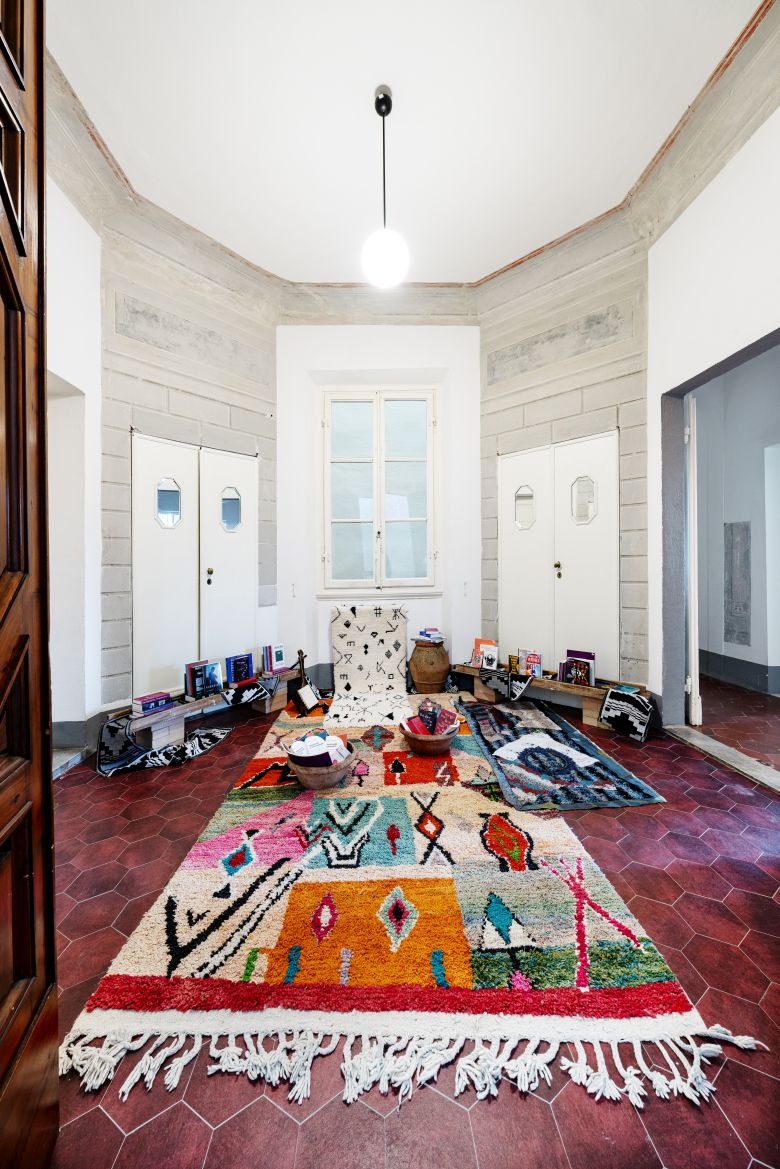
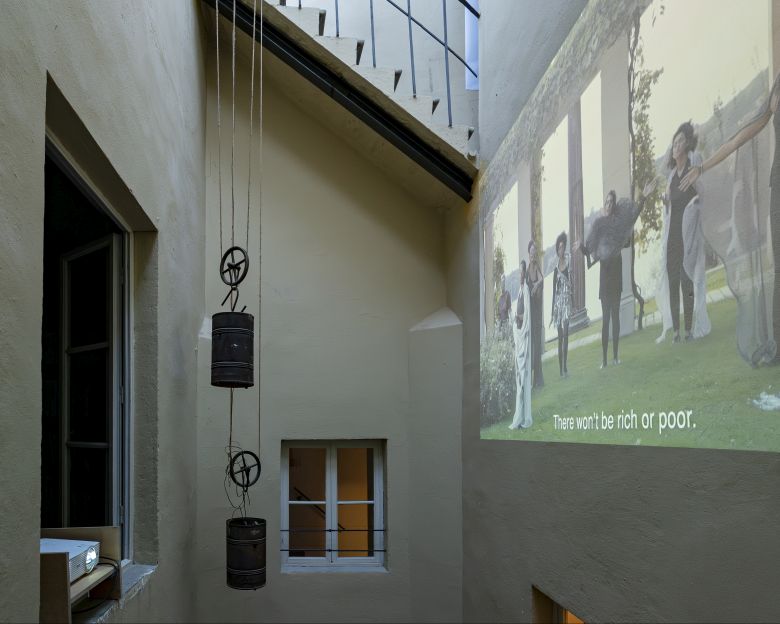
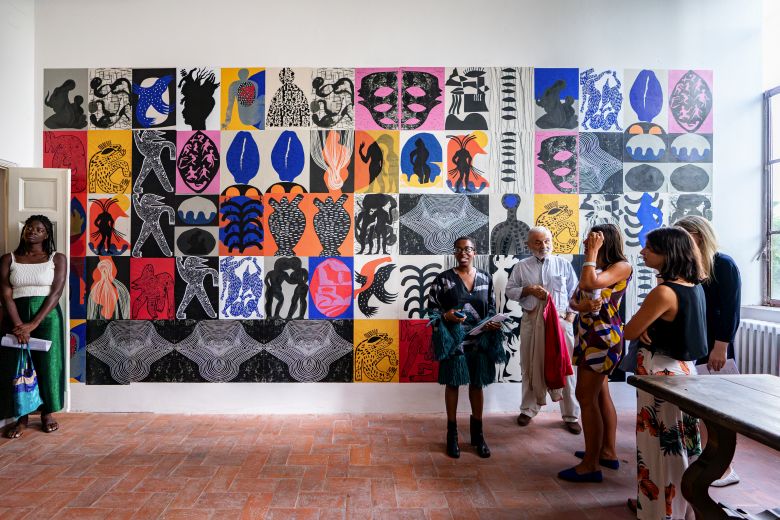



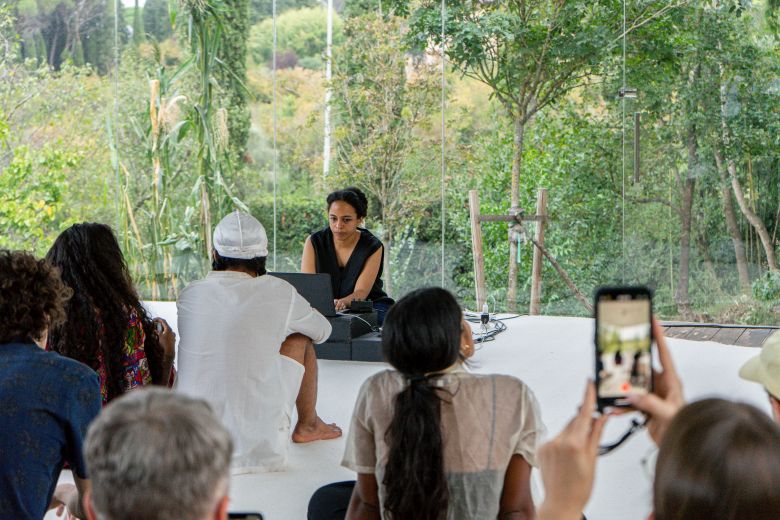

.jpg)
.jpg)

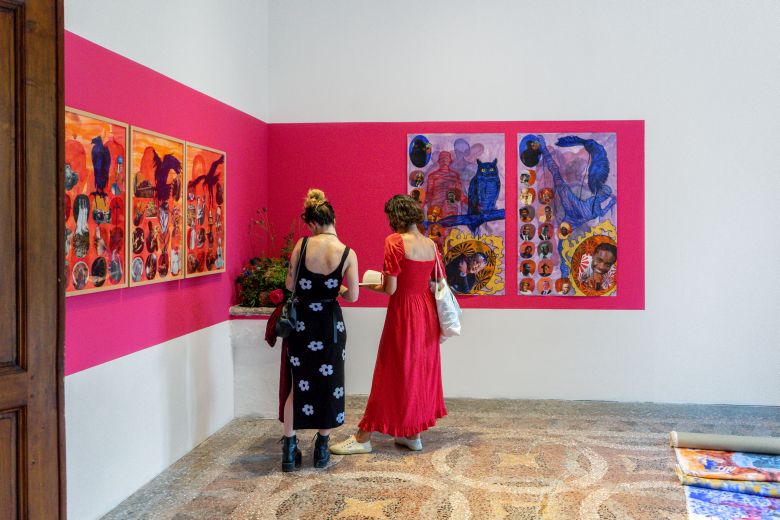
.jpg)
.jpg)
.jpg)
.jpg)


.jpg)
Credits
Director: Elena Agudio
Curator and Project Coordinator: Mistura Allison
Administration: Claudia Fromm
Production Exhibition: Giulia Del Piero
Production House: Ala Turcan, Victor Cebotaru
Art Handling: Leonardo Panci
Curatorial Assistance: Cecilia Buffa
Technical support and sound engineering: Pietro Mauro Forte(for the installation This Too Shall Pass - Tutto Passa by Emeka Ogboh at the Piazzale degli Uffizi)
Composer and translation of This Too Shall Pass - Tutto Passa: Omar Gabriel Delnevo
Archive: Carlotta Castellani
Archive Assistance: Leonie Wessel
Garden Team: Marleen Boschen, Isabella Devetta, Claudia Fromm, Victor Cebotaru, Leone Contini, Carola Haupt, Mistura Allison, Elena Agudio.
Graphic Concept: Untitled Design Agency
We give thanks to the inhabitants of Villa Romana and to all those who in the past months repeatedly contributed to its vividness: the Villa Romana Fellows and Alumni, Elena Micheli, Radio Papesse, Michele Pardo, Justin R. Thompson, Janine Gaëlle Dieudji, Jermay Micheal Gabriel, Odeon Davis, Chris Cyrill, Carmela Iziegbe, Juliane von Herz, Jonas Tinius, Edoardo e Jacopo Bottarelli, SADI, Chiara Figone, Emeka Ogboh, Paz Guevara, Lynhan Balatbat, Leila Bencharnia, Fide Dayo, Simona Fabiani, Antonella Bundu, Jasmina Metwaly, Anna Lambertini, Giacomo Zaganelli, Archipel e.V., Ilaria Cavallini, Marzia Duarte, Constance Van Berckel, Eva Sauer, the students of Master programme Spatial Strategies of the Weissensee Kunsthochschule Berlin, the collective blaxTARLINES.
We are grateful for the continuous institutional collaboration and support of: Kunsthistorisches Institut in Florenz – Max Planck Institut (KHI), The Recovery Plan, ooh-sound, Nub Project Space, ERIAC – European Roma Institute for Arts and Culture, Il Bisonte – Foundation for Art and Printmaking, Dipartimento di Architettura del Paesaggio dell’Università di Firenze, Master programme Spatial Strategies of the Weissensee Kunsthochschule Berlin, Archive Books.
We thank the board of Villa Romana for its constant support and the Kuratorium for its commitment.
Villa Romana is supported by: Bundesbeauftragte für Kultur und Medien (BKM), BAO Stiftung, Deutsche Bank Stiftung.
This exhibition project has been made possible also with the support of the Fondazione CR Firenze, thanks to the collaboration with the Kunsthistorisches Institut in Florenz (Max-Planck-Institut), and it is a partner of Florence Art Week.
Emeka Ogboh’s installation at the Piazzale degli Uffizi has the Patrocinio of the Municipality of Florence.


